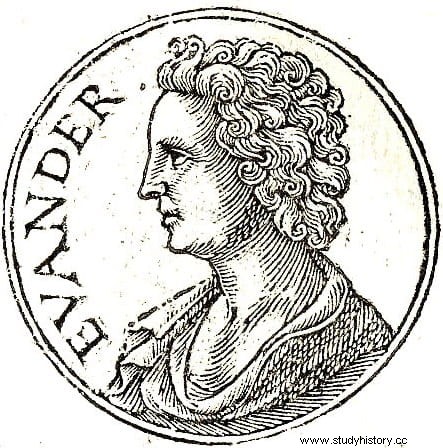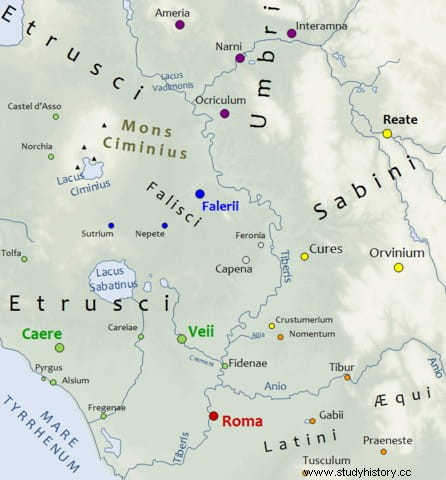The gens Fabia almost monopolized the power of Ancient Rome during the last quarter of the 5th century BC. Up to seven successive consulates chained between the years 485 and 479 BC. to later disappear from the lists for a while. The reason was because they perished en masse at the Battle of Cremera, defending their city from an invasion by their Etruscan neighbours. All the Fabios - more than three hundred - died there except for an adolescent who was pardoned because of his age and was thus able to continue his lineage; At least that's how Titus Livio tells it, although his story was called into question already in Antiquity.
A gens was a set of families identified by the same cognomen . The Romans used a praenomen (given name, used only among very close relatives), a nomen to identify your branch of the family (equivalent to the current surname) and the cognomen , which indicated which gens belonged (sometimes they also had an agnomen or nickname). The one of the Fabios was one of those considered big people , that is to say, one of the patrician houses that formed the aristocracy together with those of the Cornelios, Emilios, Claudios, Valerios and Manilos. The Fabii claimed to descend from Hercules, who would have visited the Italian peninsula before the Trojan War, although another reference ancestor was Evander, son of Mercury and the nymph Carmenta, who according to mythology had guided the Arcadians to Latium, introducing there the gods and the Greek alphabet in addition to instituting the festival of the Lupercales and being deified at his death.

Of course another legend linked that gens with Remus, one of the founders of Rome (as opposed to the Quintilios, assimilated to Romulus). In fact, one tradition attributes the cognomen at fovae , the wolf traps, revealing their relationship with one of the children suckled by the Capitoline wolf and with the outlined introduction of the Lupercalias (the Fabii were associated with one of the two colleges of Luperci priests), although Pliny the old preferred the etymology of vicia faba , a bean plant that he claims was first cultivated by the Fabians.
In any case, it was a clan of ancient ancestry that in the republican period would branch out into illustrious families such as the Vibulanos, Ambustos, Buteos, Dorsos (or Dorsuos), Labeos, Licinios, Máximos and Pictores, becoming even more complicated in the period imperial. All the branches left abundant outstanding personalities, adding together more than thirty consulates and innumerable more magistracies. As we said before, between the years 485 and 479 B.C. seven followed in a row and the series was interrupted as a result of an external danger that appeared in the distance:the threat of the Veientines.
Veii was a rich Etruscan city located just over fifteen kilometers from Rome, which guaranteed a continuous tension between the two that led them to be almost in continuous war. General Marco Furio Camilo would definitively submit it in 396 B.C. but only after a decade of fighting, in a very obvious parallel to the Trojan War which also included a siege and capture by ruse. Previously, the Veientines vied with the Romans to dominate the region and control the economy, disputing ownership of the border city of Fidenae. However, both sides had other accounts pending because after the overthrow of the monarchy, King Tarquin sought refuge among the Etruscans and convinced them to march against Rome.
Thus the year 480 BC was reached, in which the consul Cesón Fabio Vibulano barely managed to contain a Veientine campaign. It was a short-lived victory, like all those achieved in that context, since the strategy of the others was to make inroads into Roman territory and withdraw quickly, before the legions arrived. The real problem for Rome was having to attend to a double front, since they also had to repel the attacks of other Latin peoples such as the Ecuos and the Volsci. Then, the Fabii proposed an unusual solution:they would be in charge of stopping the Veientines, in what was a kind of private war campaign.
The motion was approved and a militia of four thousand men was organized, among whom were three hundred and six members of the gen s (adults over fifteen years of age, according to Tito Livio), as well as their friends and cliens (those free citizens who were under his patrocinium , that is, jurisdiction, discipline and economic protection, owing them fidelity in return). It should be said that one version attributes this initiative of the Fabios to the accusation that they were made of having alienated the rest of the gens patricians, who considered them traitors for supporting the commoners in the confrontation between the two social classes since the latter abandoned their farming tasks to retire to the Aventine, in protest at their marginalization from power.
Whether true or not, the fact is that this peculiar army set off towards the Crémera, a small river that formed the natural border with Veii, setting up a fortified camp on a hill. From there, in combination with the army of the consul Lucius Aemilius Mamercus (who had already nullified the threat of the Aequi and the Volsci), they managed to keep the Veientines at bay for two years, preventing their raids through Roman territory. By way of anecdote, it should be added that the Senate denied Mamercus the right to a triumph (a street parade to celebrate the victory) considering that the conditions he negotiated with the enemy were unfavorable.
Everything should have ended in the year 478 BC, when it became clear that the Veientines had been defeated. However, the Fabii were swollen at their success and instead of ending hostilities and returning, they insisted and dared to nonchalantly leave their position. They didn't really do it just because; their objective was to seize a large herd that the enemy had left in their retreat. Only things were not what they seemed. This is how Livio tells it:

As you can see, it was a cunning trick by the Etruscans to lure the Fabii and catch them off guard. And the Romans took the bait. Keep counting Livio:
They were not visible but they were there, hidden, waiting for the right moment. And when they considered that he had arrived, when the soldiers dispersed to gather the cattle, they threw themselves on the Fabios by surprise, surrounding them. Let's go back to Livio:
The moment was dramatic for the Romans, surrounded by a huge mass of adversaries with hardly any time or space to adopt a defense. That led them to take a drastic measure that, once again, Tito Livio tells us:
The battle ended tragically for the Fabii. They had tried and were about to get away but in the end their action in extremis it did not work and they were massacred.
That boy was Quintus Fabius Vibulanus, who over time, in 467 BC, would become consul alongside Tiberius Aemilius Mamercus, attempting to resolve the conflict between patricians and plebeians by reforming the agrarian law to distribute Volscian lands among the settlers of Antium. In a second and third consulates (with Quincio Capitolino Barbato and Lucio Cornelio Maluginense respectively) he would also face Aequi and Volsci. But it seems that the end of his life was not very honorary, since several authors accuse him of having allowed himself to be corrupted.
The really interesting thing about this character is that he appears to him as practically the only survivor of the massacre and, therefore, the savior of his lineage, something impossible for two related reasons. The first is that it is highly unlikely that the Fabii would have gone to Cremera with their wives and children. The second, related to the previous one, that Quintus Fabius Vibulanus was then too young to go to war, so he necessarily had to have stayed in Rome and if so, that would show that the family members unfit to fight (women, children , elderly…) also stayed, because it is unthinkable that they would leave him alone. A third, concomitant, is that there should have been more underage Fabios who, like him, had to wait far from the front.

Now, no one will have missed the resemblance of this episode with that of the Spartans at Thermopylae, which took place very shortly before, in 479 BC; there were even three hundred too, which is why several historians detract from its credibility ("legend or theater fiction" , Dionysius of Halicarnassus defined it), at least in the entirety of the story. Others do not see it as strange and point out that the lands of the gens Fabia extended precisely around the Cremera river and, consequently, had a special and immediate interest in avoiding the incursions of the Etruscans.
The truth is that the battle would be easily remembered not only for itself but also because it was on the same date (July 18) as that of Alia (although it was in the year 387 BC), in which the Gauls defeated the legions and sacked Rome in a campaign that originated after Marcus Fabius Ambustus's three sons (Caesus, Numerius, and Quintus) assassinated a Gallic ambassador and the Senate refused to hand them over.
Returning to the topic of the article, the Veientines scored yet another victory against the army of Titus Menenius Lanatus, sent to avenge the Fabii, and marched on Rome occupying the Janiculum (a hill outside the walls). The Romans demanded the presence of the consul Gaius Horacio Pulvilo, who hurriedly left the Volscian front and managed to stop the enemy in two clashes, in front of the Spes temple and the Colina gate, which ended in a stalemate.
The Etruscans ended up withdrawing, but not before devastating the region. Tito Livio says that in the end they fell into a trap just like the one they had set for the Fabios and were exterminated while they were looting cattle. Somewhat exaggerated, no doubt, but Veii became part of the Romans, who practically doubled their territory.
Fonts
History of Rome since its foundation (Livy Titus)/Roman Myths (Jane F. Gardner)/SPQR. A story from Ancient Rome (Mary Beard)/History of Rome (Sergei Ivanovich Kovaliov)/Clan Fabius, defenders of Rome. A history of the Republic's most illustrious family (Jeremiah McCall)/Wikipedia
